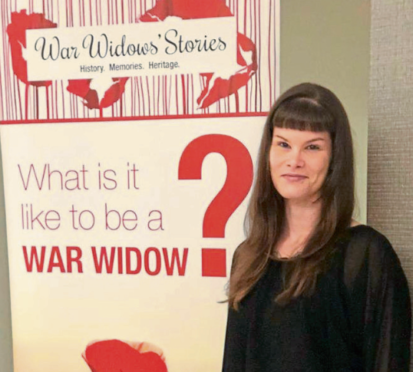Every year, the nation commemorates the sacrifices of those who have fought and fallen during service to their country.
Yet little is known about the lives and experiences of the wives and families left behind by these casualties of war.
That is something which Nadine Muller, a senior lecturer at Liverpool John Moores University, is determined to address and she has created a new project, War Widows’ Stories, designed to break the deafening silence.
This week, as part of her mission to spread the word, she will be involved in a public event at the Highlanders’ Museum at Fort George, near Ardersier.
The senior lecturer in English Literature and Cultural History first devised the venture in 2016, working in collaboration with the War Widows’ Association of Great Britain, and it has subsequently received backing from the Heritage Lottery Fund, the Art & Humanities Research Council and the British Academy.
But Ms Muller told the Press and Journal she was determined to expand it to highlight the lives, problems, passions, campaigns and future ambitions of the country’s 18,950 war widows.
She said: “The British public commonly imagines war widows to be elderly women, who lost their husbands as a result of active combat in the Second World War, surrounded and supported by family, friends, the armed forces and the state.
“While this applies to some women, it by no means describes the majority and it is crucial that the stories of war’s forgotten women are told and recorded and brought to the public’s attention.
“Death is an inevitable part of war and we cannot forget about those who are left behind and who have had to struggle every step of the way to receive any kind of support.
“These women’s stories are full of sadness and tragedy. But – and this is very important – they are also full of resilience and of memories of love and laughter.”
That message resonates with Mary Moreland, the chairwoman of the WWA, who lost her husband just before Christmas during the Troubles and had to tell her children of his death on the same day they received a school visit from Santa Claus.
The Northern Irishwoman will be at the Fort George discussion on July 20 and explained why it was so important to move beyond the perception of war widows as hapless victims of conflict with no history of their own.
Mrs Moreland said: “There is this one-dimensional aspect to how our lives are covered at the moment, almost as if we didn’t exist except while we were married.
“Yet we had careers and ambitions before we were married, we had lives and many of us had jobs and brought up children after we were married, and even while we have grieved, we have done our best to keep the show on the road.
“We want to engage with more people from all over the country, because we know there are war widows all over the UK, from the south of England to the north of Scotland, and especially where you have military bases.
“The WWA isn’t just a group for those who have lost loved ones. We are still fighting, for instance, for the reinstatement of war widows’ pensions for some women who were asked to return it because they had remarried, which was absurd.
“Of course, our lives are tinged with sadness and that is something which we know will never go away. Nobody ever wants to be a war widow.
“But we are a part of the armed forces – so don’t sweep us under the carpet.”
She believes the groundbreaking project is helping to dispel myths and lend a voice to those who have traditionally been consigned to anonymity.
And Ms Muller added: “The events we have organised – in Manchester, Portsmouth, Cardiff and at Fort George – will be a great way of bringing War Widows’ Stories to the public’s attention.
“They will also allow us to begin talking to military history museums about how the widows’ voices can make engaging and revealing additions to their exhibitions.”
For more information visit www.warwidowsstories.org.uk
